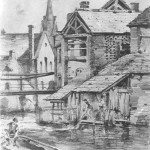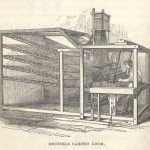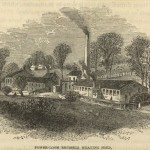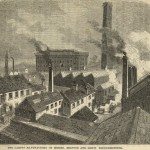Kidderminster in the mid 19th Century
Image: An image of a Kidderminster Factory showing evidence of the application of both waterpower and steam power in the weaving process. Mid 19th century. R W Boodle, Worcestershire Scrap Book, vol. II (1903).
Image from: Local Studies and History, Birmingham Central Library
In the 1830s new industrial processes, Tapestry warp printing and Chenille Axminster weaving were introduced in Kidderminster. The carpet industry expanded and by 1851 the town had a population of 17,000. The application of steam power was slow, partly because of the availability of water power for spinning and the persistence of handlooms in weaving. The creation of the Stour Vale Mill Company in 1855 which was financed by Lord Ward enabled small companies to link their spinning machines and looms to a large steam engine. A combination of the power loom and the increasing use of female labour led to male unemployment, increased trade union activity and strikes.
« Previous in this sectionNext in this section »Continue browsing this section
 Made in Kidderminster: the History of the Carpet Industry
Made in Kidderminster: the History of the Carpet Industry
 The Origins of Carpet Making in Kidderminster
The Origins of Carpet Making in Kidderminster
 The Origins of Carpet Making in Kidderminster
The Origins of Carpet Making in Kidderminster
 The Origins of Carpet Making in Kidderminster
The Origins of Carpet Making in Kidderminster
 Handloom Weaving
Handloom Weaving
 The Factory System
The Factory System
 Washing and Winding
Washing and Winding
 Washing and Winding
Washing and Winding
 Technological Changes: the Scotch Loom
Technological Changes: the Scotch Loom
 Technological Changes: the Brussels Loom
Technological Changes: the Brussels Loom
 Technological Changes: the Jacquard Loom
Technological Changes: the Jacquard Loom
 The Kidderminster Carpet Industry and the Wider World
The Kidderminster Carpet Industry and the Wider World
 The Kidderminster Carpet Industry and the Wider World
The Kidderminster Carpet Industry and the Wider World
 Working Conditions in Kidderminster Carpet Factories
Working Conditions in Kidderminster Carpet Factories
 The Great Strike of 1828
The Great Strike of 1828
 The Aftermath of the Great Strike of 1828
The Aftermath of the Great Strike of 1828
 Kidderminster in the mid 19th Century
Kidderminster in the mid 19th Century
 Kidderminster: the Factory Town
Kidderminster: the Factory Town






